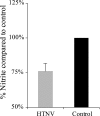Lambda interferon (IFN-lambda) in serum is decreased in hantavirus-infected patients, and in vitro-established infection is insensitive to treatment with all IFNs and inhibits IFN-gamma-induced nitric oxide production
- PMID: 17522204
- PMCID: PMC1951347
- DOI: 10.1128/JVI.00415-07
Lambda interferon (IFN-lambda) in serum is decreased in hantavirus-infected patients, and in vitro-established infection is insensitive to treatment with all IFNs and inhibits IFN-gamma-induced nitric oxide production
Abstract
Hantaviruses, causing hemorrhagic fever with renal syndrome (HFRS) and hantavirus cardiopulmonary syndrome (HCPS), are known to be sensitive to nitric oxide (NO) and to pretreatment with type I and II interferons (alpha interferon [IFN-alpha]/IFN-beta and IFN-gamma, respectively). Elevated serum levels of NO and IFN-gamma have been observed in HFRS patients, but little is known regarding the systemic levels of other IFNs and the possible effects of hantaviruses on innate antiviral immune responses. In Puumala virus-infected HFRS patients (n = 18), we report that the levels of IFN-alpha and IFN-beta are similar, whereas the level of IFN-lambda (type III IFN) is significantly decreased, during acute (day of hospitalization) compared to the convalescent phase. The possible antiviral effects of IFN-lambda on the prototypic hantavirus Hantaan virus (HTNV) replication was then investigated. Pretreatment of A549 cells with IFN-lambda alone inhibited HTNV replication, and IFN-lambda combined with IFN-gamma induced additive antiviral effects. We then studied the effect of postinfection treatment with IFNs. Interestingly, an already-established HTNV infection was insensitive to subsequent IFN-alpha, -beta, -gamma, and -lambda stimulation, and HTNV-infected cells produced less NO compared to noninfected cells when stimulated with IFN-gamma and IL-1beta. Furthermore, less phosphorylated STAT1 after IFN treatment was observed in the nuclei of infected cells than in those of noninfected cells. The results suggest that hantavirus can interfere with the activation of antiviral innate immune responses in patients and inhibit the antiviral effects of all IFNs. We believe that future studies addressing the mechanisms by which hantaviruses interfere with the activation and shaping of immune responses may bring more knowledge regarding HFRS and HCPS pathogenesis.
Figures






Similar articles
-
Alpha/beta interferon (IFN-alpha/beta)-independent induction of IFN-lambda1 (interleukin-29) in response to Hantaan virus infection.J Virol. 2010 Sep;84(18):9140-8. doi: 10.1128/JVI.00717-10. Epub 2010 Jun 30. J Virol. 2010. PMID: 20592090 Free PMC article.
-
MxA-independent inhibition of Hantaan virus replication induced by type I and type II interferon in vitro.Virus Res. 2007 Jul;127(1):100-5. doi: 10.1016/j.virusres.2007.03.027. Epub 2007 May 7. Virus Res. 2007. PMID: 17482705
-
Effects of human and murine interferons against hemorrhagic fever with renal syndrome (HFRS) virus (Hantaan virus).Antiviral Res. 1987 Nov;8(4):171-8. doi: 10.1016/0166-3542(87)90071-4. Antiviral Res. 1987. PMID: 2451468
-
Inborn errors of interferon (IFN)-mediated immunity in humans: insights into the respective roles of IFN-alpha/beta, IFN-gamma, and IFN-lambda in host defense.Immunol Rev. 2008 Dec;226:29-40. doi: 10.1111/j.1600-065X.2008.00698.x. Immunol Rev. 2008. PMID: 19161414 Review.
-
Innate and adaptive immune responses against human Puumala virus infection: immunopathogenesis and suggestions for novel treatment strategies for severe hantavirus-associated syndromes.J Intern Med. 2019 May;285(5):510-523. doi: 10.1111/joim.12876. Epub 2019 Feb 17. J Intern Med. 2019. PMID: 30663801 Free PMC article. Review.
Cited by
-
Bunyaviruses and the type I interferon system.Viruses. 2009 Dec;1(3):1003-21. doi: 10.3390/v1031003. Epub 2009 Nov 23. Viruses. 2009. PMID: 21994579 Free PMC article.
-
Autophagic clearance of Sin Nombre hantavirus glycoprotein Gn promotes virus replication in cells.J Virol. 2012 Jul;86(14):7520-9. doi: 10.1128/JVI.07204-11. Epub 2012 May 2. J Virol. 2012. PMID: 22553339 Free PMC article.
-
Innate Immunity to Orthohantaviruses: Could Divergent Immune Interactions Explain Host-specific Disease Outcomes?J Mol Biol. 2022 Mar 30;434(6):167230. doi: 10.1016/j.jmb.2021.167230. Epub 2021 Sep 4. J Mol Biol. 2022. PMID: 34487792 Free PMC article. Review.
-
Current Landscape of IFN-λ: Induction, Inhibition, and Potential Clinical Applications to Treat Respiratory Viral Infections.Immunohorizons. 2023 Apr 1;7(4):265-272. doi: 10.4049/immunohorizons.2200010. Immunohorizons. 2023. PMID: 37071039 Free PMC article.
-
What Do We Know about How Hantaviruses Interact with Their Different Hosts?Viruses. 2016 Aug 11;8(8):223. doi: 10.3390/v8080223. Viruses. 2016. PMID: 27529272 Free PMC article. Review.
References
-
- Ank, N., H. West, and S. R. Paludan. 2006. IFN-λ: novel antiviral cytokines. J. Interferon Cytokine Res. 26:373-379. - PubMed
-
- Bahl, K., S.-K. Kim, C. Calgagno, D. Ghersi, R. Puzone, F. Celada. L. K. Selin, and R. M. Welsh. 2006. IFN-induced attrition of CD8 T cells in the presence or absence of cognate antigen during the early stages of viral infections. J. Immunol. 176:4284-4295. - PubMed
-
- Bogdan, C., N. Röllinghoff, and A. Diefenbach. 2000. The role of nitric oxide in innate immunity. Immunol. Rev. 173:17-26. - PubMed
Publication types
MeSH terms
Substances
LinkOut - more resources
Full Text Sources
Research Materials
Miscellaneous

